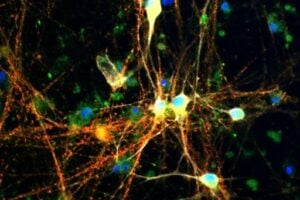Galantamine is a common medication used by people with Alzheimer’s disease and other forms of dementia around the world to treat their symptoms. Unfortunately, synthesizing the active compounds in a lab at the scale needed isn’t commercially viable. The active ingredient is extracted from daffodils through a time-consuming process, and unpredictable factors, such as weather and crop yields, can affect supply and price of the drug. (Article continued below video…)
Now, researchers at The University of Texas at Austin have developed tools — including an artificial intelligence system and glowing biosensors — to harness microbes one day to do all the work instead.
In a paper in Nature Communications, researchers outline a process using genetically modified bacteria to create a chemical precursor of galantamine as a byproduct of the microbe’s normal cellular metabolism. Essentially, the bacteria are programmed to convert food into medicinal compounds.
Less Expensive, All-Year Round
“The goal is to eventually ferment medicines like this in large quantities,” said Andrew Ellington, a professor of molecular biosciences and author of the study. “This method creates a reliable supply that is much less expensive to produce. It doesn’t have a growing season, and it can’t be impacted by drought or floods.”
Danny Diaz, a postdoctoral fellow with the Deep Proteins research group in UT’s Institute for Foundations of Machine Learning (IFML), developed an AI system called MutComputeX that is key to the process. It identifies how to mutate proteins inside the bacteria to improve their efficiency and operating temperature in order to maximize production of a needed medicinal chemical.
“This system helped identify mutations that would make the bacteria more efficient at producing the target molecule,” Diaz said. “In some cases, it was up to three times as efficient as the natural system found in daffodils.”
Fermentation + AI
The process of harnessing microbes to produce useful byproducts is nothing new. Brewers use yeast to make alcohol, and bacteria help create cheese and yogurt. Microbial fermentation is currently used to make certain types of insulin for diabetes treatment, hormones and recombinant proteins used in several drugs such as autoimmune treatments, and even vaccines. But applying AI in the process is relatively new and expands what is possible with microbial fermentation.
The research team genetically modified E. coli to produce 4-O’Methyl-norbelladine, a chemical building block of galantamine. The complex molecule is in a family of compounds extracted from daffodils that have medicinal uses in treating conditions such as cancer, fungal infections and viral infections, but using microbial fermentation to create a chemical in this family is new.
The scientists also created a fluorescent biosensor to quickly detect and analyze which bacteria were producing the desired chemicals and how much. When the biosensor, a specially created protein, comes into contact with the chemical researchers wanted to create, it glows green.
“The biosensor allows us to test and analyze samples in seconds when it used to take something like five minutes each,” said Simon d’Oelsnitz, a postdoctoral researcher formerly at UT Austin and now at Harvard University, the first author of the paper. “And the machine learning program allows us to easily narrow candidates from tens of thousands to tens. Put together, these are really powerful tools.”











